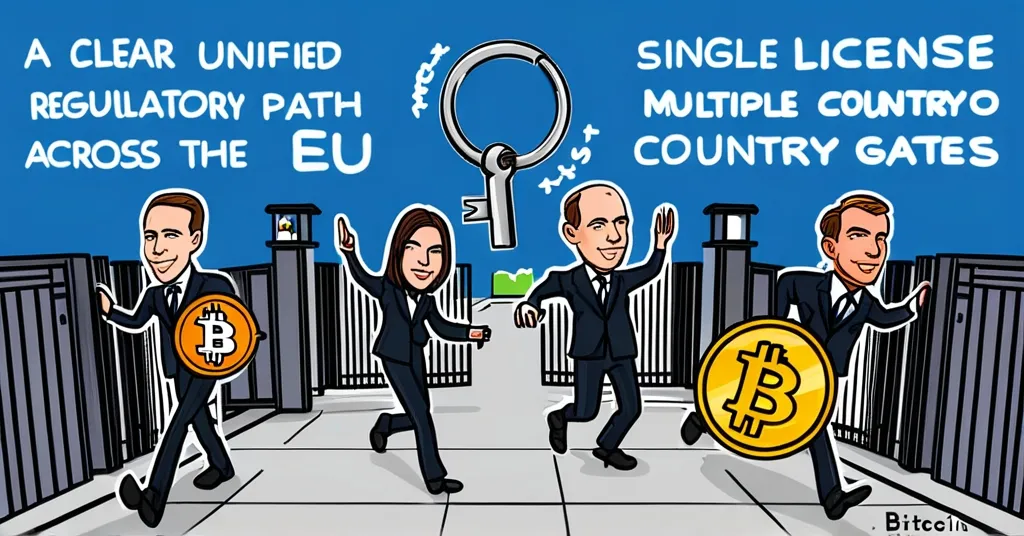Dutch AFM Grants First MiCA Licenses: MoonPay, Hidden Road, BitStaete, ZBD Lead the Way

Dutch AFM Grants First MiCA Licenses to Four Crypto Firms: A Step Towards Unified Crypto Regulation in the EU
The Dutch Authority for the Financial Markets (AFM) has issued the first four Virtual Asset Service Provider (VASP) licenses under the new Markets in Crypto-Assets (MiCA) regulation. MoonPay, Hidden Road, BitStaete, and ZBD are among the first to navigate this new regulatory landscape in the Netherlands.
- Dutch AFM issues first MiCA licenses to MoonPay, Hidden Road, BitStaete, and ZBD.
- MiCA aims to standardize crypto regulations across the EU.
- Tether and Binance face challenges adapting to MiCA rules.
What is MiCA?
MiCA, or Markets in Crypto-Assets, is a new regulation designed to standardize cryptocurrency rules across the European Union. It allows VASPs, or Virtual Asset Service Providers, to operate in 26 countries with a single license, serving a market of 450 million people with a combined GDP of $19.5 trillion. This move is part of a broader European trend, as seen in Ireland and Malta, where HashKey Europe and Socios.com have also been granted licenses.
Dutch AFM’s Role
The Dutch AFM’s decision to grant these licenses aligns with the EU’s goal of creating a more integrated and regulated crypto market. MoonPay, a Florida-based digital asset payments and transfer firm, views the license as a “pivotal step” towards solidifying the global role of the crypto industry. Ivan Soto-Wright, CEO and Co-founder of MoonPay, stated,
“We are excited to deepen our collaborations with regulators, businesses, and users as we pave the way for the future of crypto.”
This sentiment underscores the optimism surrounding MiCA’s potential to foster a more integrated and regulated crypto market.
Impact on Companies
Hidden Road, a prime brokerage with connections to various exchanges, also received a MiCA license and holds a Markets in Financial Instruments Directive (MiFID) license, making it the first firm to possess both. Michael Higgins, CEO of Hidden Road, emphasized the importance of transparency and regulation, saying,
“The license proves the firm’s commitment to serve our counterparties across traditional and digital assets in a transparent, regulated manner.”
This dual licensing highlights the firm’s commitment to bridging traditional and digital finance under a regulated framework.
BitStaete, a digital asset management firm from the Eastern Netherlands, and ZBD, which processes payments on the BTC Lightning Network, complete the list of Dutch recipients. The Lightning Network is a layer-2 solution for Bitcoin that enables faster and cheaper transactions. ZBD’s involvement with the Lightning Network showcases the innovative applications of Bitcoin technology that are now receiving regulatory nods.
In Ireland, HashKey Europe, the European subsidiary of the Hong Kong-based exchange HashKey, was granted a MiCA license. Ben El-Baz, managing director of HashKey Global, commented,
“We are excited to establish a new presence in the EU, bringing us one step closer to aligning with MiCA regulations and advancing our mission to drive responsible innovation in the digital asset space.”
This reflects the broader ambition of crypto firms to expand within the EU under a unified regulatory framework.
Malta, known for its progressive stance on blockchain, granted a MiCA license to Socios.com, a tokenized fan engagement platform operated by Chilliz. Alexandre Dreyfus, CEO of Socios.com, noted,
“The license validates our commitment to regulatory compliance and transparency in the rapidly evolving blockchain space.”
This move by Malta further cements its position as a hub for blockchain innovation.
Challenges and Opportunities
Despite the optimism, the implementation of MiCA poses significant challenges for some major players. Tether and Binance, two of the largest entities in the crypto space, face hurdles under the new regulatory framework, particularly with MiCA’s strict stablecoin rules. These rules have already led to significant redemptions of Tether’s USDT in Europe, highlighting the complexities of adapting to the new regulations. Tether and Binance might need a bigger compliance team, or at least a few more aspirin, to navigate MiCA’s rules.
While MiCA promises to unify and streamline regulations across the EU, it’s clear that the path to a fully integrated crypto market is fraught with challenges. For smaller, innovative firms, the new rules provide an opportunity to expand and operate transparently. For larger players, the journey towards compliance may be more difficult but is essential for the long-term legitimacy and growth of the crypto industry.
From a Bitcoin maximalist perspective, MiCA could be seen as a double-edged sword. On one hand, it might limit some of the freedoms that Bitcoin enthusiasts cherish, such as the ability to operate outside traditional regulatory frameworks. On the other hand, it could pave the way for broader adoption and acceptance of Bitcoin and other cryptocurrencies by providing a clearer regulatory path.
Future Outlook
As we continue to watch this regulatory evolution unfold, it’s crucial to remain both optimistic about the potential benefits and realistic about the obstacles. Decentralization and financial freedom are noble goals, but they must coexist with regulatory frameworks that protect consumers and ensure the integrity of the market. Bitcoin maximalists might view MiCA as a necessary evil, potentially limiting some freedoms while also providing a clearer path for broader adoption.
Key Questions and Takeaways
- What is the significance of the MiCA regulation?
MiCA aims to unify cryptocurrency regulations across the EU, allowing VASPs to operate in multiple countries with a single license, thereby facilitating easier market access and growth.
- How does MiCA affect the operations of VASPs?
MiCA provides a clear regulatory framework, enabling VASPs to expand their operations across the EU with greater ease and transparency, but it also imposes stringent compliance requirements that some firms may find challenging.
- Which companies received MiCA licenses in the Netherlands?
MoonPay, Hidden Road, BitStaete, and ZBD received the first MiCA licenses from the Dutch AFM.
- What advantages does MiCA offer to companies like HashKey Europe?
MiCA allows HashKey Europe to establish a presence in the EU and align with the new regulations, facilitating responsible innovation and market expansion.
- Why are Tether and Binance facing challenges under MiCA?
Tether and Binance are facing challenges due to MiCA’s strict stablecoin regulations, which have led to significant redemptions of Tether’s USDT in Europe, and broader regulatory scrutiny on their operations.



